Apple's MacBook Pro: Using it as a Mac and a PC
by Anand Lal Shimpi on April 13, 2006 12:00 AM EST- Posted in
- Mac
The MacBook Pro: So very similar, yet so very different
When Apple first announced that it had accelerated the introduction of the Intel based Macs and introduced the iMac Core Duo and MacBook Pro, I was not impressed. Maybe it was that my expectations were too high, but for Apple's first attempt at an Intel based Mac I expected a design that would blow me away. I expected the reaction to the Mac mini, but with even more punch, yet all I got were brand new internals in the same old exterior.
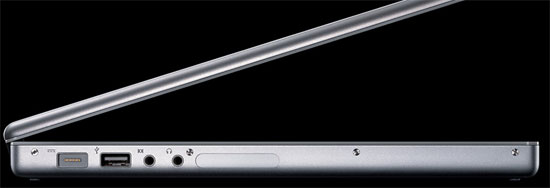
Compared to the G5, the new Core Duo processors were significantly less power hungry. As I showed in my iMac Core Duo review, you're looking at about 2/3 of the power consumption of the G5 yet the new CPUs were kept in the same chassis. For the MacBook Pro I expected something that was thinner than ever before, I expected Apple to virtually defy the laws of notebook making and truly deliver the most amazing thing I had ever seen running an Intel processor. Instead, Apple introduced something that looked very similar to my PowerBook G4 - but with a new power connector.
Part of the problem is that it took several weeks after the first announcement of the MacBook Pro for units to even be available to the public. At launch you couldn't go out and actually play with one of the new systems at an Apple store. I state this as a problem because after actually handling a MacBook Pro, the individually small improvements are pretty nice in the aggregate.
Compared to my 15" PowerBook G4 the 15" MacBook Pro is ever so slightly thinner; my PowerBook measured 1.1" in thickness and the new MacBook Pro is an even 1". Apple actually made the MacBook Pro slightly larger than its predecessor at 14.1" x 9.6" vs. 13.7" x 9.5" of the older PowerBook G4, but by making the unit slightly thinner and longer/wider the MacBook Pro actually ends up feeling a lot smaller than its predecessor. The slim theme continues even to Apple's packaging, as the MacBook Pro comes in a fairly thin (for a notebook) box. Much of the impact is psychological, but the MacBook Pro honestly does feel smaller than its predecessor despite being larger in two of its three dimensions. After putting the MacBook Pro in the same place on my desk that my PowerBook G4 used to sit, though, the MacBook Pro is definitely bigger.
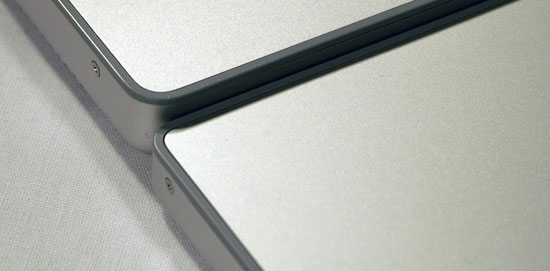
PowerBook G4 (top) vs. MacBook Pro (bottom)

PowerBook G4 (top) vs. MacBook Pro (bottom)
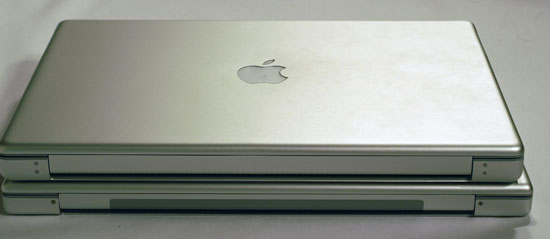
PowerBook G4 (top) vs. MacBook Pro (bottom)
One of my first complaints about the PowerBook G4 was that the latch that kept the display lid closed felt like it would be the first thing to break. Thankfully it never has, but it never made me feel comfortable. On the MacBook Pro, Apple addressed the issue and replaced the single latch with a pair of latches. They are still controlled by the single button at the front of the unit but the end result is a more flush fitting display lid when closed and a much higher quality feel.
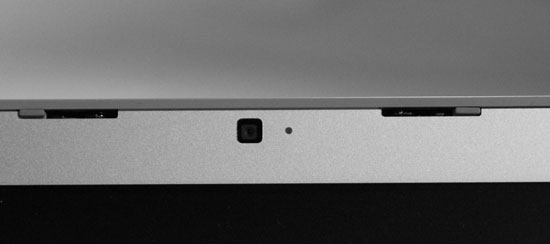
There's one latch on either side of the iSight camera
The construction overall appears to be better than the PowerBook G4, which held up fairly well while being in use for over a year. Unfortunately, the MacBook Pro does have a couple of assembly related issues, both of which are visible on the keyboard itself. A few of the keys squeak a lot when depressed, mainly the spacebar. More bothersome is the fact that two keys are poorly mounted. The eject button is by far the worst on the unit I'm reviewing as removing the key and replacing it doesn't actually put it back in line with the rest of the function keys. The only solution for this problem is to take it back to Apple.
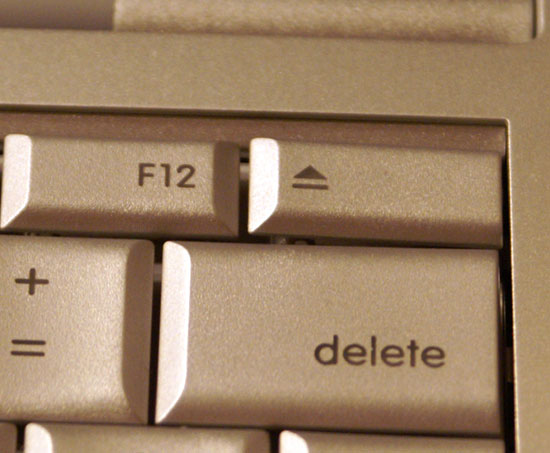
The eject key looks like it's not set properly, but there's no fixing it. Apple quality control at its best.










52 Comments
View All Comments
nels0360 - Thursday, April 13, 2006 - link
The hardware issue mentioned have been or are being fixed.Apple has release silent revisions of the MacBook Pro. It is well documented on other sites such as Macrumors.com
In fact, I believe Apple will give you a new revision if you complain about one of these problems.
plinden - Thursday, April 13, 2006 - link
I know they are different benchmarks, but over at http://www.macworld.com/2006/04/firstlooks/xpbench...">MacWorld, they found that the MacBook Pro was faster at running Windows than three Windows-only PCs.I'm not going to editorialize here, just bringing this to your attention.
ss284 - Friday, April 14, 2006 - link
Which pretty much drops macworld's benchmark credibility to zero. Actually, their credibility was already really low so its no big deal.ss284 - Friday, April 14, 2006 - link
Unless the benchmark was how fast it could burn a hole in your pants and sterilize your important parts.jbb132 - Thursday, April 13, 2006 - link
Sadly, even the most recent MacBook Pro's continue to suffer from the hardware problems you noticed. I've now had two units with the "whine," particularly when the laptop is running on battery power. The only way to stop it is to turn photobooth on and leave it on. Various hacks (magicnoisekiller in particular) help but really...Pirks - Thursday, April 13, 2006 - link
Hey Anand!Thanks for an interesting review! Now, what was the video source codec and resolution in your H.264 encoding test? I've got a Mac zealot here saying he's got only 2 frames per second in similar H.264 encoding task. He also has Mac OS X 10.4.6 and Quicktime Pro 7.0.4. I wonder is you used source with resolution like 160 by 120 for that test??
To other readers: take with a grain of salt Anand's view on running multiple apps simultaneously in XP. He says something like "uh oh we can't run multiple apps all the time on win coz win can't manage its RAM blah blah", but in fact if you disable XP swap AND if you stick 2 or 3 gigs or RAM in your mobo you'll get my experience of running dozens of apps open at the same time and even some games while at it (DOOM 3 + Matlab + Maya 7 + other little apps like VDub open at the same time is a no brainer on my XP). Stick 4 gigs and open even more, without loss of performance. In fact if you wanna get Mac OS X experience, just stuff your mobo with RAM and turn off swap, that's it, no need to spend $$$ on Mac to get this "experience" :-))
One last minor correction - Anand tells you "anything more than 2GB of RAM on your PC is useless" but he does not know about /3GB switch (google up "/3GB switch") which again allowed me to run Matlab with THREE gigs or RAM consumed, not two.
Just my 2 cents to debunk some myths that Mac zealots love to spread ;) Don't get caught in that stuff, read docs/mans and be smart.
Anand Lal Shimpi - Friday, April 14, 2006 - link
The source for my H.264 test was the Hoodwinked trailer from Apple's Quicktime trailers site.My comments about memory usage and Windows XP have nothing to do with the /3GB switch. The point I was trying to make is that Windows XP does not do a good job of caching to reduce disk accesses. Microsoft itself has admitted that there's lots of room for improvement, which is why you hear about all of the caching improvements that will be introduced in Vista.
Take care,
Anand
kleinwl - Thursday, April 13, 2006 - link
BTW: if you don't think that anandtech knows about the /3GB switch you certainly haven't been here very long.Pirks - Thursday, April 13, 2006 - link
Did Anand ever mention this switch in any of his reviews? Or anyone else besides him from AT staff? I've never seen it before. How about you? Would you provide me with a link or some other proof? I'd love to be corrected here, since AT guys should know about it, and I wish I were wrong stating the opposite, especially about Anand himself.As for the stability - I run Matlab with 3GB consumed routinely, it also loads some Maya 7 stuff internally via my own DLL and there's another Maya 7 hanging around to check results from Matlab quickly, and I never saw a slightest glitch. Of course YMMV but I heard too much "omg windoze is 2GB limited and mac is TrUe 64-bit WoNdEr" and I've got some experience with Matlab on both Mac OS X (no 64-bit matlab there) and WinXP (now this is true 64-bit product) to let Anand repeat that kind of sh.t. Mac guys are ok to say that, they live like this, so no big deal but not Anand please :-) So let's just say "please Anand be a bit more correct in some places and don't sound like a dumb Mac user", saying windows can't properly run a lot of apps at once and stuff like that.
Speaking of Vista I've read somewhere on MSDN that a lot of XP 64 code is in there so it _should_ be as robust as XP 64 with regard to RAM handling. I'm sure after SP1 or SP2 it'll be absolutely rock solid :-)
kleinwl - Thursday, April 13, 2006 - link
I've used the /3GB switch as well... however it can (and does) degrade the stability of your system (running fluent (a CFD program) on XP SP2). I wouldn't run around recommending the normal use of the /3GB switch. Some programs don't even support it (ie. Catia V15). Ultimately we upgraded to XP x64 (which came with it's own headachs).2.5GB seems to be the most that XP SP2 can really handle well.. everything else is a waste. OS X just does a better job handing large amounts of ram and not "losing" it with time.
I am interested is seeing how VISTA will perform and if will be as good as OSX or XP x64 with ram... or something quite better (or worse).